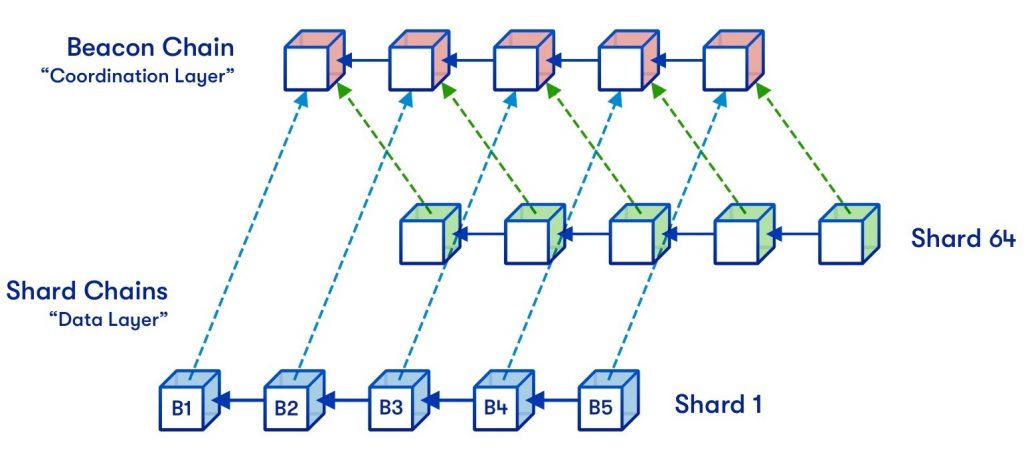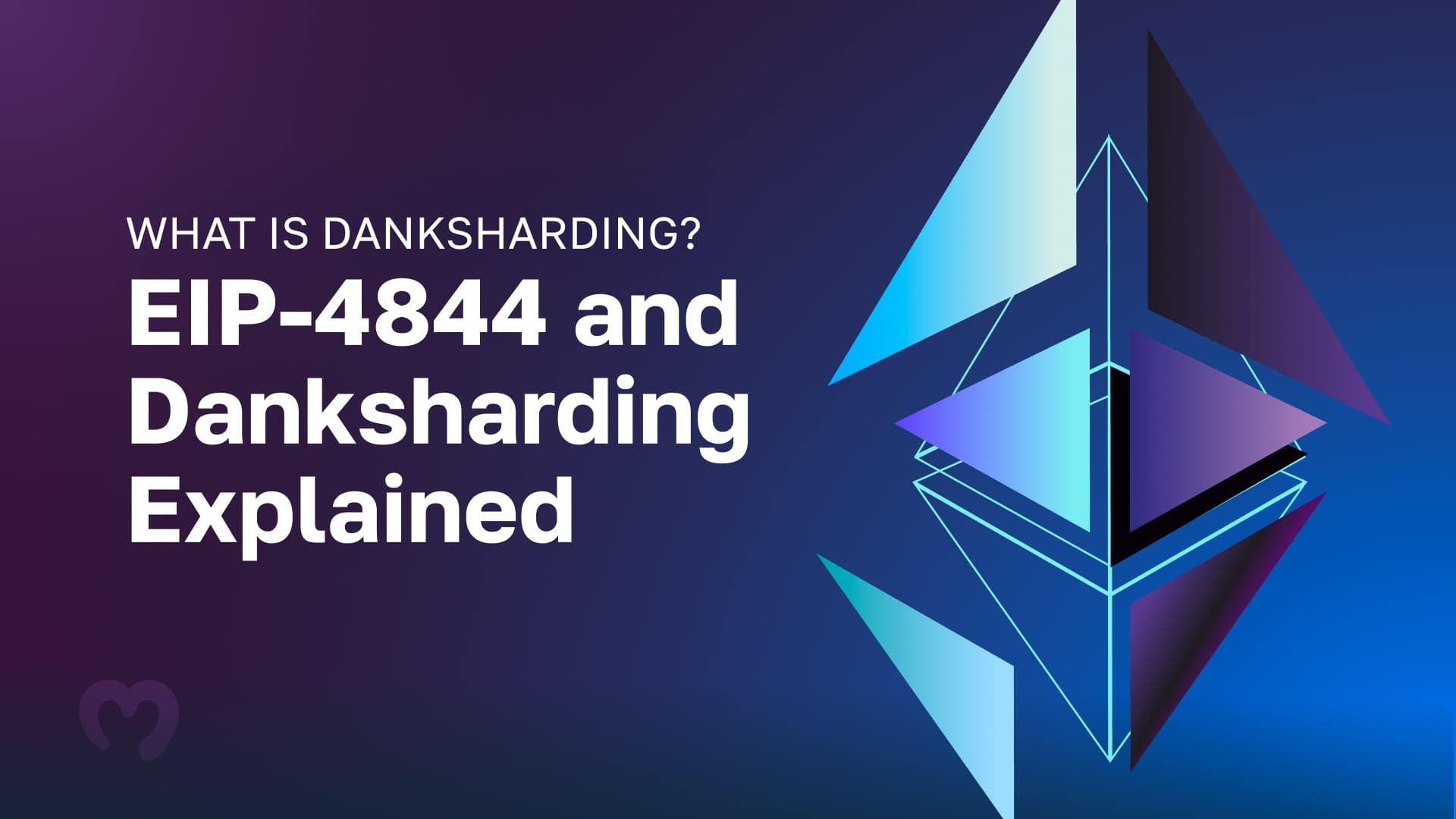It’s no secret that the Ethereum community has been troubled by congestion and scalability points, inducing exorbitant fuel charges and different unfavorable consumer situations. Though these issues can’t be attributed to a single supply, two distinguished examples embrace elevated adoption and the utmost extractable worth (MEV) dynamic, enabling validators to arbitrarily exclude, embrace, and re-order transactions on the expense of customers. However, the truth that there are scalability points is sort of evident. Nonetheless, the million-dollar query is, how ought to we sort out these unfavorable situations? Nicely, one, amongst a number of solutions to this query, is danksharding. However what’s danksharding, and the way does it work? These are two questions we got down to reply on this article. If this excites you, be a part of us as we dive deeper into the intricacies of danksharding!
Nonetheless, earlier than overlaying the ins and outs of danksharding, the article will lay the inspiration by overlaying the fundamentals of sharding normally. From there, we soar straight into the principle subject, introducing danksharding and the way it works. Then, to prime issues off, the article covers EIP-4844, often known as proto-danksharding.
What’s extra, if you’re already conversant in the idea of danksharding, contemplate trying out different Moralis content material right here on the Web3 weblog. For example, learn in regards to the intricacies of the Goerli testnet or discover ethers.js dapp improvement. Additionally, you possibly can learn to get all NFT transfers from any pockets utilizing Moralis’ NFT API! Plus, discover our tutorial on the right way to get token metadata!
The aforementioned software programming interface is one among many Web3 APIs from Moralis. If you would like entry to all of them and revel in a considerably extra seamless developer expertise, enroll with Moralis now! Doing so is free, and with an account, you possibly can absolutely leverage the facility of blockchain know-how!
What’s Sharding?
Centralized database administration generally makes use of the sharding approach. Moreover, it refers to splitting an in depth database into much less important components or ”shards”. In doing so, builders can enhance effectivity and scalability by distributing a database throughout a number of machines working in parallel.
Each time an software or platform experiences elevated adoption, it usually will increase the quantity of saved information. As you possibly can think about, an overloaded database negatively impacts the efficiency of an software/platform, harming the consumer expertise. Nonetheless, by way of sharding, it’s attainable to alleviate a database’s overload to scale back redundant load time.
However, with a quick overview of sharding normally, what does it entail in a Web3 context? The basic ideas stay the identical, and sharding a blockchain means splitting the community into distinct shards. Every shard is answerable for storing a portion of the chain’s information and dealing with a singular subset of transactions. What’s extra, like sharding in conventional databases, it will probably probably enhance the community’s scalability and latency capabilities.
Furthermore, a standard idea you may need to familiarize your self with is ”shard chains”. Shard chains are elements containing the fractions of the information that deal with the subset of transaction processing duties. In brief, shard chains are smaller blockchains working individually and independently from the principle community. Nonetheless, every shard chain submits a document to its major chain at frequent intervals.
Since all shard chains have distinctive transaction histories and their very own set of nodes validating transactions, it’s attainable to have numerous shard chains run concurrently. This will enhance community latency and enhance throughput through parallel processing.
Now that you’ve got a greater understanding of what sharding entails, each inside conventional improvement and in a Web3 context, allow us to additional discover the issue sharding in blockchain networks goals to resolve within the subsequent part!
Why is Sharding in Blockchain Networks Needed?
In most blockchain networks, most nodes want to achieve a consensus to validate transactions. A disadvantage of that is that the networks can solely course of a small variety of transactions concurrently. Furthermore, nodes are usually required to retailer the complete historical past of a blockchain. That is important to how blockchains reminiscent of Bitcoin and Ethereum stay decentralized and may forestall fraudulent conduct. Nonetheless, with the notions of decentralization and excessive safety, these networks are pressured to sacrifice their scalability capabilities.
So, how are blockchain networks going to resolve these points with out going again on safety and decentralization? That is the place sharding enters the equation to alleviate this subject. Via sharding, nodes can forgo the requirement of downloading the complete historical past of the chain and keep away from the necessity to validate all community transactions. Consequently, networks change into extra environment friendly and scalable, positively impacting the consumer expertise as demand will increase!

So, now that you’ve got a extra profound understanding of what sharding is and why it is vital, allow us to dive into the central a part of this information and discover the intricacies of danksharding!
Danksharding Defined
Now that you’re extra conversant in sharding normally, it’s time for the information’s major subject: danksharding. So, what’s it? Danksharding is a more moderen sort of sharding structure proposed for the Ethereum community and will get its title from the researcher Dankrad Feist. This new design introduces some distinguished simplifications in comparison with earlier alternate options. In earlier sharding frameworks, the intention has usually been to extend the area for transactions. In distinction, danksharding takes a rollup-centric strategy by offering extra space for ”blobs” (extra on “blobs” beneath) of knowledge, which the Ethereum protocol itself doesn’t attempt to interpret.
”Blobs” is an abbreviation for ”binary massive objects”, and they’re usually fairly intensive. Nonetheless, they’re comparatively low cost to transact with because the consensus layer shops them moderately than Ethereum’s computation-heavy execution layer. Consequently, the computation layer doesn’t want to fret in regards to the particulars of the information. Moreover, it will probably as an alternative concentrate on the commitments of the information blobs.
Moreover, danksharding implements the ”merged charge market” idea, which is among the central underlying improvements behind this sharding design. Nonetheless, what does this imply, and the way does it work?
How Does Danksharding Work?
As touched on briefly, one of many central underlying modern ideas behind danksharding is the merged charge market; nevertheless, what does this imply? Nicely, as an alternative of getting a specified variety of shards, every having its personal distinct blocks and block proposers, in danksharding, it’s a single proposer selecting all information and all transactions that go into a selected slot.
Furthermore, as a way to be sure that the merged charge market design doesn’t pressure important system necessities on validators, Ethereum launched ”proposer/builder separation”, or PBS. In a PBS-based system, a brand new specialised class of actors often known as block builders bids for the suitable to decide on the contents of a slot, and proposers solely want to decide on the legitimate header with the very best bid. As such, solely the block builder is required to course of the complete block; in the meantime, different customers and validators can confirm blocks extra effectively through information availability sampling.
Via information availability sampling, nodes can confirm bigger portions of knowledge by way of a pattern. Consequently, since nodes can keep away from processing all information, the Ethereum community can deal with bigger portions of knowledge, offering a less expensive and quicker community extra suited to scaling and rollup optimization!
Nonetheless, danksharding is considerably sophisticated and comparatively complicated. As well as, because of this complexity, it will probably take fairly a while earlier than the Ethereum community is ripe for danksharding, which is the place EIP-4844 enters the image to introduce proto-danksharding!
What’s Proto-Danksharding? – EIP-4844
With the present state of Ethereum, many issues should be settled earlier than the community is able to undertake full danksharding. Right here is the place EIP-4844 enters the image – a proposal for implementing proto-danksharding. EIP stands for ”Ethereum Enchancment Proposal”, and EIP-4844 goals to implement many of the logic and lay the groundwork for full danksharding specs.
Nonetheless, the proposal doesn’t but embrace any precise implementation of sharding. Consequently, in proto-danksharding, validations and customers nonetheless must validate the provision of the whole information instantly.
The proto-danksharding proposal’s most distinguished function is a brand new transaction sort: ”blob-carrying transactions”. These are fairly much like conventional transactions, solely that they carry a further piece of knowledge blobs. Blobs are usually fairly intensive however will be cheaper than equal quantities of name information. Furthermore, this information sort will not be accessible for EVM (Ethereum Digital Machine) execution, and the digital machine can solely view commitments to those objects.
Since shoppers and validators are nonetheless required to obtain the complete contents of the blobs, the bandwidth in proto-danksharding is geared toward 1 MB/slot as an alternative of the entire 16 MB. Nonetheless, there are nonetheless important scalability beneficial properties to be made because the information will not be competing with the traditional fuel utilization of present blockchain transactions.
That briefly covers the intricacies of proto-danksharding/EIP-4844. Within the following part, we’ll examine proto-danksharding with EIP-4488, which is an earlier and simplified proposal aiming to resolve the identical subject.
What’s EIP-4488? – EIP-4844 vs EIP-4488
Now that you’ve got familiarized your self with EIP-4844 (often known as proto-danksharding), allow us to take a more in-depth take a look at a considerably comparable enchancment protocol: EIP-4488. EIP-4488 is an earlier and extra simple try to resolve the identical subject. Nonetheless, this enchancment protocol goals to do it by way of the next two guidelines:
A restrict of 10 MB/block, plus an additional 300 bytes/transactionReducing name information fuel prices from 16 fuel/byte to three fuel/byte
The onerous restrict is among the most simple strategies of guaranteeing {that a} important enhance within the common caseload doesn’t result in a rise in worse caseload. As such, EIP-4844 makes an attempt to scale back the fuel prices of name information. Nonetheless, this can be a short-term answer that may show irrelevant if there was full sharding, as shards would make the most of blobs.
To briefly summarize, the principle distinction is that EIP-4844 aligns with the complete sharding roadmap. In the meantime, EIP-4488 goals to resolve the problem in the interim. Nonetheless, this doesn’t imply we should understand the 2 enchancment protocols as trade-offs or aggressive. As proto-danksharding may take a while to implement because of engineering technicalities, EIP-4488 will help clear up excessive prices utilizing rollups.
That covers this tutorial on danksharding. When you’ve got adopted alongside this far, you now hopefully know what danksharding is and the way it works. Within the subsequent part, we’ll present a quick abstract together with different articles that you just may discover attention-grabbing!
Abstract – What’s Danksharding? – EIP-4844 and Danksharding Defined
On the subject of the Web3 area, sharding refers back to the strategy of splitting up a blockchain into smaller ”shards”. Every shard is answerable for dealing with a portion of the chain’s transactions, together with storing a choice of its information. Moreover, sharding can convey many advantages, reminiscent of elevated scalability and better throughput.
One sort of sharding technique that has obtained an abundance of consideration currently is danksharding, which takes a rollup-centric strategy to sharding. Nonetheless, although danksharding is likely to be a sound answer to Ethereum’s scalability points sooner or later, the community will not be able to undertake this sharding design. However that is the place EIP-4844 or proto-danksharding enters the image!
Proto-danksharding is an EIP (Ethereum Enchancment Proposal) aiming to implement the elemental ideas and lay the groundwork for danksharding. The principle function of EIP-4844 is a brand new transaction sort referred to as blob-carrying transactions. Nonetheless, proto-danksharding nonetheless requires validators and shoppers to obtain the complete contents of the blobs. As such, bandwidth is considerably restricted and geared toward 1 MB/slot. Nonetheless, it nonetheless presents alternatives for important scalability beneficial properties.
However, in case you discovered this tutorial on danksharding useful, contemplate studying different articles right here on the Moralis weblog. For example, take a look at our tutorial on Web3 py and discover Ethereum Python implementation. As well as, learn to hearken to sensible contact occasions utilizing ethers.js or learn up on the Sepolia testnet!
What’s extra, if you wish to change into a more adept Web3 developer, enroll in Moralis Academy in the present day! The academy gives industry-leading blockchain programs for each new and extra skilled builders. For example, be taught the fundamentals with the course on Ethereum fundamentals.
Lastly, keep in mind to enroll with Moralis to entry a extra seamless workflow for all of your future blockchain improvement endeavors!
































